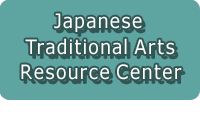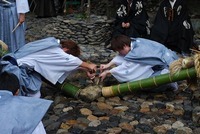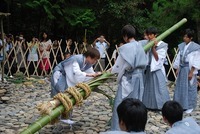

Total:35items
- Folk Performing Art (16)
- Kabuki (2)
- Noh & Kyogen (1)
- Festival (10)
- Wakubata woolen banner event of Kumakabuto Hatsuka Festival
- Hakone Feudal Lord's Procession Festival
- Uozu’s Tatemon Event
- Yama-age Event (Yama-age Festival)
- Yoshidanohimatsuri: Fire Festival of Yoshida
- Potato-comparing Festival in Nakayama, Oumi
- Noto's Kiriko Festival
- Ara-odori (Sankasho Shrine Festival)
- Mi-fune event in Kouchi Festival
- Nozawa Onsen Dosojin Festival
- Ritual & Ceremony (2)
- Puppet Play (2)
- Folk technology (2)

 |
|
 《Feature》
《Feature》Potato-comparing Festival in Nakayama of Oumi is a part of a ceremony in which the east side and the west side of Nakayama village competing the length of potatoes. The contest will be held at the end of an ancient-style ceremony on Nogamiyama (Mt. Nogami), and by this contest, they can predict a fortune about good or bad harvest; if the winner is the west team, they will have good harvest and if the east team wins, they will have bad harvest. It used to be held as a ritual of August in the lunar calendar. However, the date was changed to 1st September in the solar calendar since 1971.
The potato used in this ritual is a kind of taro which is called "Tounoimo". They compete by measuring their length from the beginning of roots to the end of leaves in order to pray for good harvest.
There are four kinds of coordinators in this ritual: "Yamako", "Yamawaka", "Miyaza", and "Katte".
"Yamawaka" referred to 14 boys aged above 16, while formed by 7 boys from each side. They are responsible for executing all the matters in the ceremony with the wearing of "Kamishimo" (a kind of formal Japanese clothing for men which were worn until the end of Edo period (17-19c)). "Yamako" are children aged from 8 to 14, who have an important task to build the ceremony site with Japanese clothing made of Kasuri (a kind of Japanese textile). "Miyaza", also called "Otona", is formed by 13 elders from the village, who has played the role of Yamawaka. Their position can be viewed as elder statesmen of the ceremony. "Katte" is men chosen from those who has been Yamawaka before. They wear Haori-bakama (a kind of Japanese formal attire including traditional jacket and trousers), and will be in charge of preparing items needed for each scene during the ritual.
At the early morning of 1st September, the day of the ritual, members of both the east side and the west side dig the potatoes chosen on the day before, and start decorating them for the ceremony. At 1pm, signal is given by a drum, Yamako of each side will move toward to Kumano Shrine with their potatoes tying with bamboo decoration. After entering the shrine, they first visit the shrine office and hold the San-San-Kudo no Sakazuki (a custom of drinking Sake with several people). After that, each group will carry the potato to the ceremony site through different decided path.
The ground of ceremony site is filled with stones by Yamako at the end of August. The main ritual will start when both Yamako and Yamawaka reach their decided position. At this time, Ichibanjo (the eldest of the Yamawaka from each team) act as the agent of the god.
It proceeds with the oblation of the potato and dishes of food, including Mochi (round rice cake), Wori (rice dough in the shape of carps), Semba (stalks of potatoes), Budo (square rice doughs), Kamouri (a kind of melon), Sasage (a kind of bean). Yamako and Yamawaka are also having the same dish as well. All ceremonies are showing the respect to god. The next is Sumo wrestling by Yamako, having Sanbanjo (the third eldest of Yamawaka from each team) as a referee.
Finally, the potato contest begins. Nibanjo (the second eldest of Yamawaka from each team) will be the master of the ceremony and Sanbanjo will measure the length of potato with the staggeringly like a drunkard, this process is called "Imo-wo-Utsu". Both teams will insist that their own side is winning when the result is announced. Thus, they will repeat this process several times.
Finally the contest ends when the winning side announces the real result and the losing side admits they lose. The announcements made in this process will be spoken with a unique expression (pharse of wordings), which is one of the interesting characteristics of this ceremony enjoyed by the audience. At the end of the contest, they will exchange their potatoes and worship the god. The whole ceremony will end as they descend the mountain.
[National Important Tangible Assets of Folk Culture]
Provided by: Shiga-Bunka-no-Susume
Translation: Aki Tobayama, reviewed by Chan Yee Ting
| City/Town | 1931 Nakayama, Hino-cho, Kamoi-gun, Shiga Pref. |
|---|---|
| Location | Place: Kumano shrine (Nakayama Hinocho Kamoigun Shiga Pref.)
Date: 1st September of every year |
| Contact | Hino Town Tourist Association (Hino Kanko Kyoukai)
Tel: 0748-52-6577 |
| Highlight/POI | The unique expression used when of announcing the length of the potatoes, which phrases like "The potato of the west is one or two...or three, or four... or five, or six jyo (1jyo=about 3 meters) longer than the potato of the west." You can never see such funny characteristic in other festival. This traditional festival has been inherited from parents to children over 800 years.
|
| General Participation | Visitors can see the event.
Place: Kumano shrine (Nakayama, Hinocho, Kamoigun, Shiga Pref.) Date: 1st September of every year |



